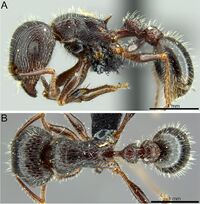Tetramorium margueriteae
| Tetramorium margueriteae | |
|---|---|

| |
| Scientific classification | |
| Kingdom: | Animalia |
| Phylum: | Arthropoda |
| Class: | Insecta |
| Order: | Hymenoptera |
| Family: | Formicidae |
| Subfamily: | Myrmicinae |
| Tribe: | Crematogastrini |
| Genus: | Tetramorium |
| Species group: | solidum |
| Species: | T. margueriteae |
| Binomial name | |
| Tetramorium margueriteae Mbanyana, Robertson & Hita Garcia, 2018 | |
Nothing is known about the biology of Tetramorium margueriteae.
Identification
Mbanyana et al. (2018) - Morphologically, T. margueriteae is similar to Tetramorium peringueyi, Tetramorium dichroum and Tetramorium brigitteae in that, these are the only species in the T. solidum species group with erect simple hairs covering the entire body. This species can be separated from T. peringueyi on the basis of colour and the pattern of the sculpture on the mesosoma. Tetramorium margueriteae is black in colour, whereas T. peringueyi is orange to light brown. In T. peringueyi, the dorsal surface of the mesosoma has a strongly developed irregular reticulate sculpture, whereas in T. margueriteae the dorsum of the mesosoma has short longitudinal rugulae, and the ground sculpture is mainly smooth and shiny, with peripheral patches of fine, superficial reticulations. Tetramorium margueriteae is separated from both T. dichroum and T. brigitteae by the presence of erect hairs on the antennal scapes.
Keys including this Species
Distribution
South Africa: Western Cape, Northern Cape and Eastern Cape.
Latitudinal Distribution Pattern
Latitudinal Range: -29.035271° to -29.06211°.
| North Temperate |
North Subtropical |
Tropical | South Subtropical |
South Temperate |
- Source: AntMaps
Distribution based on Regional Taxon Lists
Afrotropical Region: South Africa (type locality).
Distribution based on AntMaps
Distribution based on AntWeb specimens
Check data from AntWeb
Countries Occupied
| Number of countries occupied by this species based on AntWiki Regional Taxon Lists. In general, fewer countries occupied indicates a narrower range, while more countries indicates a more widespread species. |

|
Estimated Abundance
| Relative abundance based on number of AntMaps records per species (this species within the purple bar). Fewer records (to the left) indicates a less abundant/encountered species while more records (to the right) indicates more abundant/encountered species. |

|
Habitat
Known from Nama Karoo and Drakensberg Montane Grasslands.
Biology
Castes
Nomenclature
The following information is derived from Barry Bolton's Online Catalogue of the Ants of the World.
- margueriteae. Tetramorium margueriteae Mbanyana, Robertson & Hita Garcia, 2018: 33, figs. 4F, H, 16, 24 (w.) SOUTH AFRICA.
Unless otherwise noted the text for the remainder of this section is reported from the publication that includes the original description.
Description
Worker
(N = 6) HL 1.059–1.163 (1.107); HW 1.137–1.279 (1.199); SL 0.775–0.930 (0.840); EL 0.245–0.258 (0.256); PH 0.472–0.610 (0.528); PW 0.710–0.827 (0.764); WL 1.201–1.356 (1.281); PSL 0.167–0.207 (0.183); PTH 0.369–0.423 (0.392); PTL 0.388–0.413 (0.405); PTW 0.388–0.452 (0.415); PPH 0.439–0.594 (0.499); PPL 0.362–0.388 (0.377); PPW 0.478–0.530 (0.502); OI 20–23 (21); CI 107–110 (108); SI 66–74 (70); DMI 58–61 (60); LMI 39–45 (41); PSLI 14–19 (17); PeNI 52–56 (54); LPeI 98–109 (103); DPeI 100–106 (103); PpNI 62–68 (66); LPpI 65–82 (76); DPpI 127–141 (133); PPI 116–124 (121).
Holotype. Mandibles with longitudinal striations. Anterior clypeal margin with extensive, semicircular indentation. Frontal carinae extending back from frontal lobes as fine ridges and ending at about level of anterior eye margin. Eyes with 16 ommatidia in longest row. Propodeum armed with pair of medium length propodeal spines, longer than basal width (PSLI 14–19). Metapleural lobes low with angled corner. Peduncle with prominent keel-shaped subpetiolar process. Petiolar node in profile nodiform, with posterior face slightly more steeply angled than anterior face; anterior face rounding onto dorsum but with slightly angled corners as seen in dorsal view. Postpetiolar node low and rounded. Dorsal surfaces of head with longitudinal striations, spaces between them with superficial reticulate ground sculpture. Dorsum of mesosoma with short longitudinal striations, with superficial ground sculpture in between them. Petiolar and postpetiolar nodes with fine reticulate sculpture overlain by irregular striations. Gastral tergite with fine, superficial reticulate pattern. All dorsal surfaces of head and body with abundant fine, erect, and short hairs. The tibia of middle and hind legs with numerous short, stout, erect hairs. Ventral surface of head with strongly developed psammophore. Colour uniformly black.
Type Material
Holotype. South Africa: Northern Cape: worker, Klein Pella, road between Karsten Farms and Goodhouse, Kokerboom site, 29.06211° S, 18.97985° E, 832 m a.s.l., Gariep Rocky Desert with Kokerboom and Euphorbia, 16 Dec. 2007, N. Mbanyana and H.G. Robertson leg. (SAM-HYM-C019829) South African Museum. Paratypes. South Africa: Northern Cape: 24 pinned workers, same collection data as for holotype (SAM-HYM-C019827, SAM-HYM-C019836, SAM-HYM-C019838, SAM-HYM-C019839).
Etymology
Named after Marguerite Blignaut who helped with molecular lab work on the T. solidum group.
